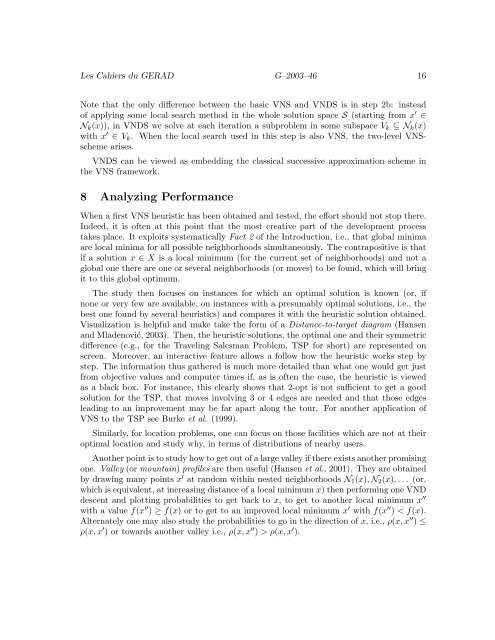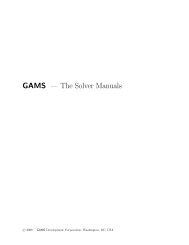A Tutorial on Variable Neighborhood Search
A Tutorial on Variable Neighborhood Search
A Tutorial on Variable Neighborhood Search
Create successful ePaper yourself
Turn your PDF publications into a flip-book with our unique Google optimized e-Paper software.
Les Cahiers du GERAD G–2003–46 16<br />
Note that the <strong>on</strong>ly difference between the basic VNS and VNDS is in step 2b: instead<br />
of applying some local search method in the whole soluti<strong>on</strong> space S (starting from x ′ ∈<br />
N k (x)), in VNDS we solve at each iterati<strong>on</strong> a subproblem in some subspace V k ⊆N k (x)<br />
with x ′ ∈ V k . When the local search used in this step is also VNS, the two-level VNSscheme<br />
arises.<br />
VNDS can be viewed as embedding the classical successive approximati<strong>on</strong> scheme in<br />
the VNS framework.<br />
8 Analyzing Performance<br />
When a first VNS heuristic has been obtained and tested, the effort should not stop there.<br />
Indeed, it is often at this point that the most creative part of the development process<br />
takes place. It exploits systematically Fact 2 of the Introducti<strong>on</strong>, i.e., that global minima<br />
are local minima for all possible neighborhoods simultaneously. The c<strong>on</strong>trapositive is that<br />
if a soluti<strong>on</strong> x ∈ X is a local minimum (for the current set of neighborhoods) and not a<br />
global <strong>on</strong>e there are <strong>on</strong>e or several neighborhoods (or moves) to be found, which will bring<br />
it to this global optimum.<br />
The study then focuses <strong>on</strong> instances for which an optimal soluti<strong>on</strong> is known (or, if<br />
n<strong>on</strong>e or very few are available, <strong>on</strong> instances with a presumably optimal soluti<strong>on</strong>s, i.e., the<br />
best <strong>on</strong>e found by several heuristics) and compares it with the heuristic soluti<strong>on</strong> obtained.<br />
Visualizati<strong>on</strong> is helpful and make take the form of a Distance-to-target diagram (Hansen<br />
and Mladenović, 2003). Then, the heuristic soluti<strong>on</strong>s, the optimal <strong>on</strong>e and their symmetric<br />
difference (e.g., for the Traveling Salesman Problem, TSP for short) are represented <strong>on</strong><br />
screen. Moreover, an interactive feature allows a follow how the heuristic works step by<br />
step. The informati<strong>on</strong> thus gathered is much more detailed than what <strong>on</strong>e would get just<br />
from objective values and computer times if, as is often the case, the heuristic is viewed<br />
as a black box. For instance, this clearly shows that 2-opt is not sufficient to get a good<br />
soluti<strong>on</strong> for the TSP, that moves involving 3 or 4 edges are needed and that those edges<br />
leading to an improvement may be far apart al<strong>on</strong>g the tour. For another applicati<strong>on</strong> of<br />
VNS to the TSP see Burke et al. (1999).<br />
Similarly, for locati<strong>on</strong> problems, <strong>on</strong>e can focus <strong>on</strong> those facilities which are not at their<br />
optimal locati<strong>on</strong> and study why, in terms of distributi<strong>on</strong>s of nearby users.<br />
Another point is to study how to get out of a large valley if there exists another promising<br />
<strong>on</strong>e. Valley (or mountain) profiles are then useful (Hansen et al., 2001). They are obtained<br />
by drawing many points x ′ at random within nested neighborhoods N 1 (x), N 2 (x),... (or,<br />
which is equivalent, at increasing distance of a local minimum x) then performing <strong>on</strong>e VND<br />
descent and plotting probabilities to get back to x, to get to another local minimum x ′′<br />
with a value f(x ′′ ) ≥ f(x) or to get to an improved local minimum x ′ with f(x ′′ ) ρ(x, x ′ ).
















